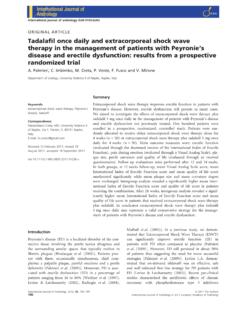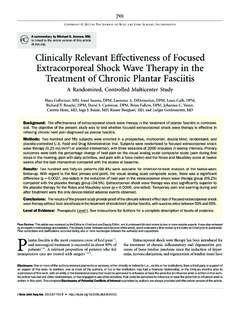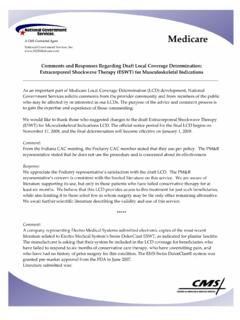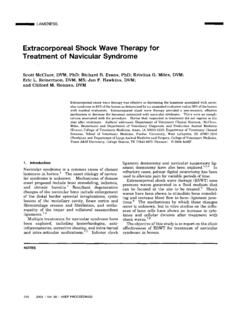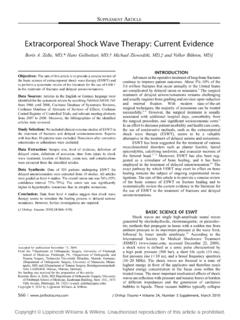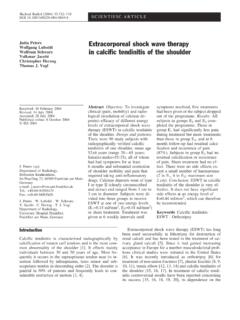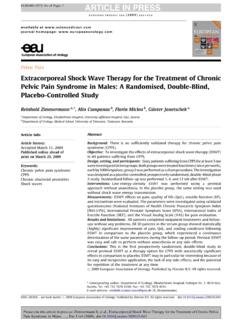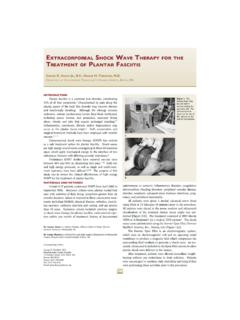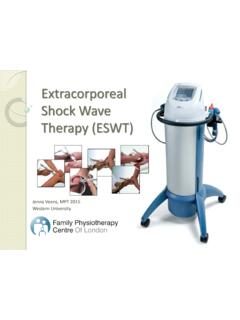Transcription of Low-Intensity Extracorporeal Shock Wave Therapy—A Novel ...
1 ORIGINAL RESEARCH ERECTILE DYSFUNCTIONLow-Intensity Extracorporeal Shock Wave therapy A NovelEffective Treatment for Erectile Dysfunction in Severe ED PatientsWho Respond Poorly to PDE5 Inhibitor Therapyjsm_2498 Gruenwald, MD, Boaz Appel, MD, and Yoram Vardi, MDNeuro-urology Unit, Rambam Healthcare Campus, Haifa, IsraelDOI: Shock wave therapy (LI-ESWT) has been reported as an effective treatment in menwith mild and moderate erectile dysfunction (ED). aim of this study is to determine the efficacy of LI-ESWT in severe ED patients who were poorresponders to phosphodiesterase type 5 inhibitor (PDE5i) was an open-label single-arm prospective study on ED patients with an erection hardness score(EHS) 2 at baseline. The protocol comprised two treatment sessions per week for 3 weeks, which were repeatedafter a 3-week no-treatment interval. Patients were followed at 1 month (FU1), and only then an active PDE5imedication was provided for an additional month until final follow-up visit (FU2).
2 At each treatment session, LI-ESWT was applied on the penile shaft and crus at five different anatomical sites (300shocks, mJ/mm2intensity at120 shocks /min).Each subject underwent a full baseline assessment of erectile function using validated questionnaires and objectivepenile hemodynamic testing before and after Outcome measures used are changes in the International Index of Erectile Function-erectile function domain (IIEF-ED) scores, the EHS measurement, and the three parameters of penile hemody-namics and endothelial men (mean age of ) completed the study. Their mean IIEF-ED scores increased 1 (baseline) to 1 at FU1 (P= ). At FU2 (on active PDE5i treatment), their IIEF-ED furtherincreased to 1(P< ), and (P< ) reached an EHS of 3 (allowing full sexual intercourse).A significant improvement (P= ) in penile hemodynamics was detected after treatment and this improvementsignificantly correlated with increases in the IIEF-ED (P< ). No noteworthy adverse events were LI-ESWT is a new modality that has the potential to treat a subgroup of severe ED preliminary data need to be reconfirmed by multicenter sham control studies in a larger group of ED I, Appel B, and Vardi Y.
3 Low-Intensity Extracorporeal Shock wave therapy A Novel effectivetreatment for erectile dysfunction in severe ED patients who respond poorly to PDE5 inhibitor therapy . JSex Med 2012;9:259 Intensity Extracorporeal Shock Wave therapy ; Erectile Dysfunction; PenisIntroductionErectile dysfunction (ED) is one of the mostcommon disorders of middle-aged men thatprofoundly affect their quality of life [1]. Althoughtremendous advances for treating this disorderhave been made in the past decade, most currentlyavailable treatment modalities still rely on an ondemand regime, of which up to 35% are unsuc-cessful [2 4]. From our experience, ED patientswho were treated with a phosphodiesterase type 5inhibitor (PDE5i) tend to search for an alternative259 2011 International Society for Sexual MedicineJ Sex Med 2012;9:259 264treatment modality that would ameliorate theirED. Hence, there is a need for an effective newtreatment concept that would have a durableeffect on the spontaneous improvement of recently reported on the efficacy of a noveltherapy, namely, applying Low-Intensity extracor-poreal Shock wave therapy (LI-ESWT) to thepenis of patients with vasculogenic ED [5].
4 Resultsfrom in vitro and in vivo studies have shown thatLI-ESWT induces neovascularization [6 8], andthis finding was the theoretical basis for initiatingstudies on using LI-ESWT for treating ED. Theresults of our first preliminary research on EDpatients who were responsive to PDE5i therapyshowed that this treatment modality enhancespenile perfusion and substantially improves erec-tile function [5].A number of studies have been published onimproving efficacy of PDE5i in men who do notrespond or respond poorly to PDE5i therapy [9,10], suggesting potential ways to increase theefficacy of PDE5i therapy but not proposingany innovative treatments. Today, patients un-satisfied with response to oral therapy are candi-dates for either intracavernosal injections orpenile implants. As most responders to PDE5iare usually managed by general practitioners inthe primary health care setting, poor respondersor severe ED patients are mainly referred tourologists and are managed in ED clinics. If LI-ESWT would be proved to be effective in thesemore severe ED patients, such a unique modalitycould expand our urological treatment armamen-tarium in the management of ED.
5 It is againstthis background that we undertook the currentstudy in which we evaluated the efficacy ofLI-ESWT in severe ED men who were poorresponders to PDE5i and MethodsThis was an open-label single-arm prospectivepilot study approved by the local ethics study had a screening phase, a 12-weekLI-ESWT phase, applied to the patient s genitalarea, and a 2-month evaluation phase (Figure 1).Only men over 40 in a stable relationship(>3 months), who were previously diagnosed withED at our outpatient clinic and were registered aspoor responders to PDE5i therapy , were eligiblefor screening. In order to ensure that these menwere poor responders, they were thoroughly ques-tioned in regard to the dosage of the PDE5i, thetiming of its intake, and the concomitant sexualstimulation. Men who could not provide definiteanswers were given four tablets of PDE5i and thenasked to return for follow-up after they had com-pleted their treatment. At this follow-up examina-tion, the severe ED and poor responders wereidentified and then recruited for the study.
6 Our keyinclusion criterion was a low erection hardnessscore (EHS) of zero to two during PDE5i excluded men (i) with an unstable medical orpsychiatric condition, (ii) with a previous history ofa neurological pathology, and (iii) after radicalpelvic surgery, irradiations, or hormonal screening, written informed consent anddemographic data were obtained from each par-ticipant. Assessment of erectile and sexual functionduring PDE5i treatment was determined using theInternational Index of Erectile Function-erectileFigure 1 Study flow chart. EHS,erection hardness score; FMD, flowmediated dilatation; FU, follow-up;IIEF-ED, International Index of ErectileFunction-erectile function domain;PDE5i, phosphodiesterase type 5inhibitor; QEQ, Quality of et Sex Med 2012;9:259 264function domain (IIEF-ED) score, the Quality ofErection Questionnaire (QEQ), and determina-tion of the EHS. We used the flow mediated dila-tation (FMD) technique for objective evaluation ofthe participant s penile hemodynamics and endot-helial function [11,12].
7 After completion of theassessments, the first of the 12 LI-ESWTs wasthen administered. In the treatment phase, weused the identical treatment protocol that we usedin our first study [5]. The treatment protocol con-sisted of two treatment sessions per week for3 weeks, which were repeated after a 3-weekno-treatment interval. At each treatment session,LI-ESWT was applied on the penile shaft and crusfor 3 minutes at five different penile anatomicalsites. Each LI-ESWT comprised 300 shocks pertreatment point at an energy density of mJ/mm2and a frequency of 120/min. One month afterthe end of treatment (FU1), the results ofLI-ESWT without PDE5i therapy were evaluatedusing the identical methods that were used atscreening. As the main aim of this study was toassess the effect and benefit of LI-ESWT on thisspecific population of poor responders, we thenprovided an active PDE5i medication regime toeach study participant, which comprised fourtablets of a PDE5i that each man selected accord-ing to his best personal experience.
8 One monthlater (FU2), we reassessed erectile function usingthe identical methods that were used at main outcome measures for success werechanges in the IIEF-ED, the EHS measurement,and the three parameters of penile hemodynamicsand endothelial AnalysisA repeated-measures analysis of variance (anova)was used to investigate the overall effects of treat-ment by comparing the effect of LI-ESWT on thestudy parameters at visit 1 to those from FU1 (neteffect without PDE5i therapy ) and at visit 1 tothose from FU2 (under PDE5i treatment). TheTukey test was used to investigate the specific pair-wise differences in the IIEF-ED, the QEQ scores,and the maximum FMD arereported as least squares mean the pooled stan-dard error of the least squares mean (sem).The binomial test was used to determine theproportion of treatment successes after treatmentat FU1 and FU2 and the significance of the differ-ence between the two changes in the EHS values for each studyparticipant were compared by Bowker s test.
9 Forthis purpose, the study group was divided into twosubgroups: those who achieved a score of three tofour on each follow-up visit and those who did not,and then comparing their scores with those thatwere determined at baseline, where none hadscored three or rank correlation was used to establishthe relationship between the changes in the penilehemodynamics and endothelial function and thechanges in the IIEF-ED from visit 1 to data were statistically analyzed using JMPD iscovery Software (SAS Institute, NC, USA);statistical significance was at 5%.ResultsThirty-three men entered the study after screen-ing. Four men discontinued due to study non-compliance [2] and protocol violation [2]. Theremaining 29 men who met the inclusion exclusion had a mean IIEF-ED of and a medianED duration of 60 months. Other detailed baselinecharacteristics are displayed in Table 1. The menwere middle-aged with coronary heart disease, dia-betes mellitus, or cardiovascular risk factors, hadsevere ED for more than a year, and were incapableof full sexual FU1, subjects reported improved erectilefunction, as measured by significantly increased(P= ) IIEF-ED (Figure 2), and 10 ( )also reported increased penile rigidity (Figure 3).
10 Two months after end of the treatment (FU2),while on PDE5i therapy , the mean IIEF-EDincreased by 10 points ( 1 [standard devia-tion],P< ) (graph 1). In fact, eight men( ) were normalized according to theIIEF-ED ( 25), and the IIEF-ED domain scoresimproved in 22 men ( ) by at least five men ( ) reported an EHS value 3(P< ; see Figure 3). On average, themen noted some improvement in their erectilefunction, 3 weeks after the start of LI-ESWT,which was usually between the sixth and eighthtreatment 1 Baseline patient characteristicsMean age (years) range (years)41 79 Cardiovascular risk factorsN PercentHypertension24 27 smoker12 artery disease16 mellitus21 Wave therapy for Erectile Dysfunction261J Sex Med 2012;9:259 264 The secondary outcome measures that wereused to assess the effect of LI-ESWT on erectilefunction were the total IIEF and the QEQ scores increased significantly from baselineto FU2 (IIEF vs. ; QEQ scores: ,P< for both).Penile endothelial function improved signifi-cantly (P= ) after LI-ESWT, as assessed bythe three parameters of penile hemodynamics andendothelial function, namely, maximal postis-chemic blood flow (Figure 4), basal blood flow,and the area under the flow-time curve (AUC).
